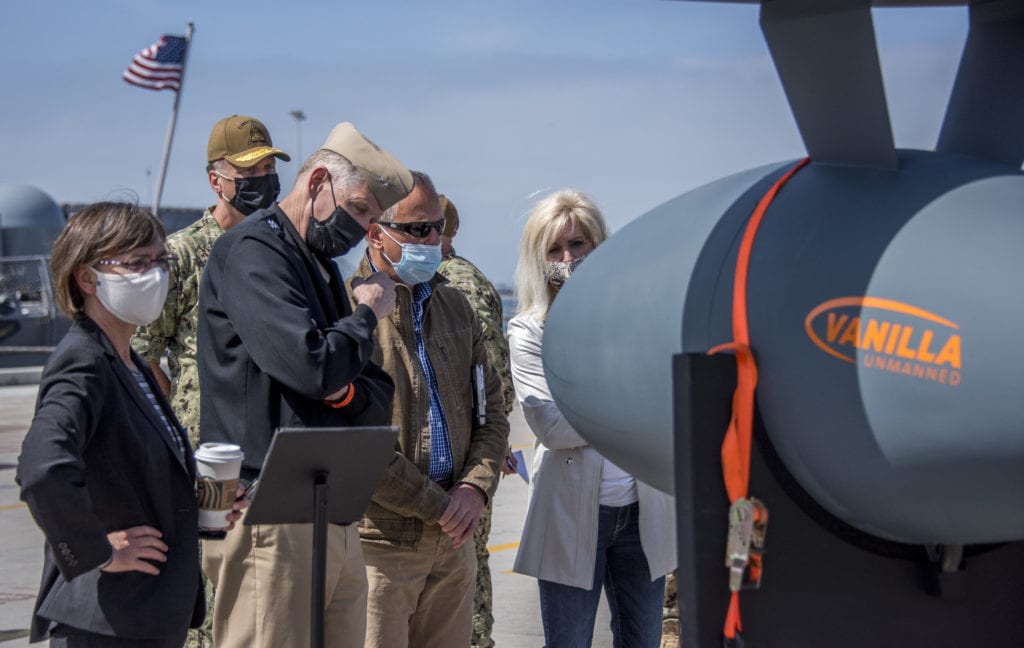
ARLINGTON, VA. — The U.S. Navy’s first large-scale unmanned systems (UxS) integrated battle problem (IBP) will involve manned/unmanned teaming and has a goal of developing a targeting solution for a planned missile shoot, the IBP executive agent said.
The battle problem, led by the U.S. Pacific Fleet and executed by U.S. 3rd Fleet, began April 19 and is being conducted under the command of Rear Adm. James Aiken, commander, Carrier Strike Group Three.
“This integrated battle problem provides an operational approach to integrating and adapting unmanned technology with our manned fleet,” Aiken said, speaking April 20 in a teleconference with reporters. “Various manned systems, including littoral combat ships, two classes of destroyers, an amphibious transport dock ship, and fixed and rotary-wing aircraft will test their enhanced capabilities alongside unmanned systems through operationally challenging scenarios and vignettes during this exercise.
“This exercise generates warfighting advantages for our fleet by providing the operational environment to work through tactics, techniques, procedures, command and control, to integrate the fleet and we are ready to execute,” he said. “Our operational integration of these unmanned systems is here in our fleet today above the sea, on the sea and below the sea.
“We want to move to a capability, to start applying operational concepts,” he said. “Foundationally, when actually planning this exercise, Sailors were part of the planning.
“Our goal for this exercise is to evaluate these unmanned systems and how they can actually team with manned systems,” he said. “As we team all those together, we will be able to evaluate what we can do and what we can’t do in trying to create a warfighting advantage … then we’re going to make sure we get it into the hands of the Sailors. We need to move things from the technical community to the tactical community.”
Aiken said one of the vignettes of most interest is the most challenging: using “a combination of manned and unmanned assets in order to get after a target and provide a targeting solution. At range we’re going to put a missile on the target.”
The admiral was not at liberty to name the type of missile to be used.
Unmanned systems participating in the IBP include two medium-displacement unmanned surface vessels, Sea Hunter and its new sister ship, Seahawk; MQ-8B Fire Scout UAV; MQ-9 Sea Guardian UAV; Vanilla ultra-long-endurance UAV; Office of Naval Research’s Super Swarm Project; and the Ocean Aero Triton-Class Dual-Modality Underwater and Surface Autonomous Vehicle.
Manned ships participating in the IBP include the Zumwalt-class guided-missile destroyer (DDG) USS Michael Monsoor; the Arleigh Burke-class DDGs USS Spruance, USS John Finn, USS Stockdale and USS Fitzgerald; Ticonderoga-class guided-missile cruiser USS Princeton; Freedom-class littoral combat ship (LCS) USS Fort Worth; Independence-class LCS USS Coronado; San Antonio-class amphibious transport dock ship USS Anchorage; and Los Angeles-class attack submarine USS Hampton.
Manned aircraft participating include the P-8A Poseidon, E-2C Hawkeye, EA-18G Growler, MH-60R Seahawk and MH-60S Seahawk.
- Insitu Going Strong at 30, Focusing on Maritime Operations - April 8, 2024
- Navy Awards Boeing Additional Funds for MQ-25 Drones for Testing - April 3, 2024
- Benign 4th Fleet AOR Useful for Unmanned Vehicle Operationalization, Admiral Says - March 27, 2024






